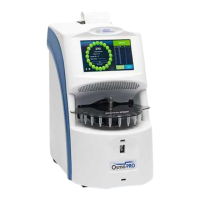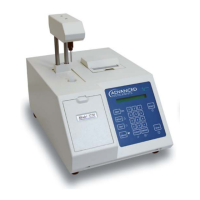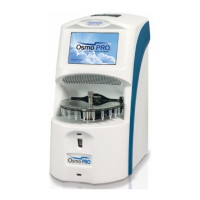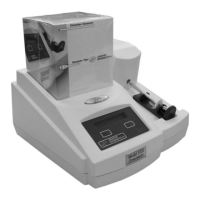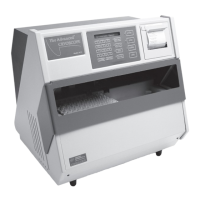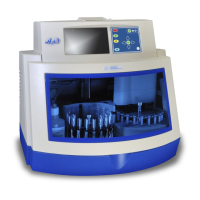Chapter 5: Testing Samples
OsmoPRO MAX Automated Osmometer User Guide
47
• Micro-samples are more susceptible to contamination
and evaporation than larger samples. Cold samples
are susceptible to condensation; warmer samples are
susceptible to evaporation.
• Cross-contamination from previous samples can
aect results obtained from a subsequent test. To
minimize this eect when testing samples where the
expected range is appreciably dierent from previous
tests, run two or more replicates of the new sample
and disregard the first result.
• If an occasional sample produces irregular results but
the instrument is producing accurate readings,
discard the irregular readings and repeat the sample
in question.
• For repeat runs, use additional samples from the
same source.
• No special sample preparation is required for serum
samples. Other body fluids such as urine may be
tested directly.
• When using blood collection tubes with separator
gels, make sure that the sample volume above the gel
satisfies the minimum volume requirements in the
table below.
• If the pipettor tip contacts the gel, the osmolality
reported may be aected. If contact occurs, prime the
system to remove any gel inside the pipettor tip and
then clean the exterior using 70% isopropyl alcohol.
• Small volume samples can be run using the Small
Volume Insert Kit (p/n 552923) from Advanced
Instruments. A minimum volume of 170 μL is required
for a single test.
Up to three replicates may be run using the small
volume inserts. Each additional replicate sample
requires a minimum volume of 150 μL.
When using these smaller receptacles, insert them
into the open ends of the sample tubes that have
been placed into the turntable.
WARNING: The total height of the primary
tube and a small volume insert (if used)
cannot exceed 100 mm to avoid the pipettor
striking the top of the insert and causing
damage to the instrument and/or the
primary tube.
For best performance when using small
volume insert tubes, it is recommended that
they be placed in a 75 mm tall tube.
• The following tables specifies the minimum volumes
required in typical sizes of sample tubes to test one
sample while ensuring proper operation of the liquid
level detection and pipettor systems.
Based on the sample tube being used, the minimum
volume is dispensed into each tube for a single test.
Each additional replicate sample requires a minimum
volume of 150 μL.
WARNING: The maximum tube length is
100 mm. Using sample volumes below the
minimums specified could result in:
• Insucient sample being aspirated for
testing.
• The pipettor striking the bottom of the
sample receptacle,causing damage to the
product or receptacle.
– The minimum volumes listed must be present
above the gel separation layers of serum collection
tubes after centrifuging.
– To ensure proper liquid level detection when testing
liquids with extremely low dielectric properties
(such as de-ionized water), use a tube filled to near
capacity with the liquid.
– To ensure proper liquid level detection when testing
samples contained in ampules, use a lint-free cloth
or swab to carefully remove any liquid film present
at the ampule opening.
IMPORTANT: The minimum sample volumes shown are
based on the dimensions of commonly-available tubes.
Actual minimum sample volumes may vary based on
the model of tube used.
Primary
Tube
Minimum Sample Volume (µL) for one
test
1
Nominal
Tube Size
(Diameter)
Spherical Bottom Flat Bottom
11 mm
480 µL 660 µL
12 mm
2
550 µL 780 µL
13 mm
630 µL 910 µL
14 mm
700 µL 1060 µL
15 mm
770 µL 1220 µL
16 mm
850 µL 1380 µL
17 mm
920 µL 1560 µL
1 Represents the minimum sample volume prepared for the instrument—not the
sample volume consumed.
2 Available from Advanced Instruments - Disposable Glass Sample Tube Set
(p/n 552921)
